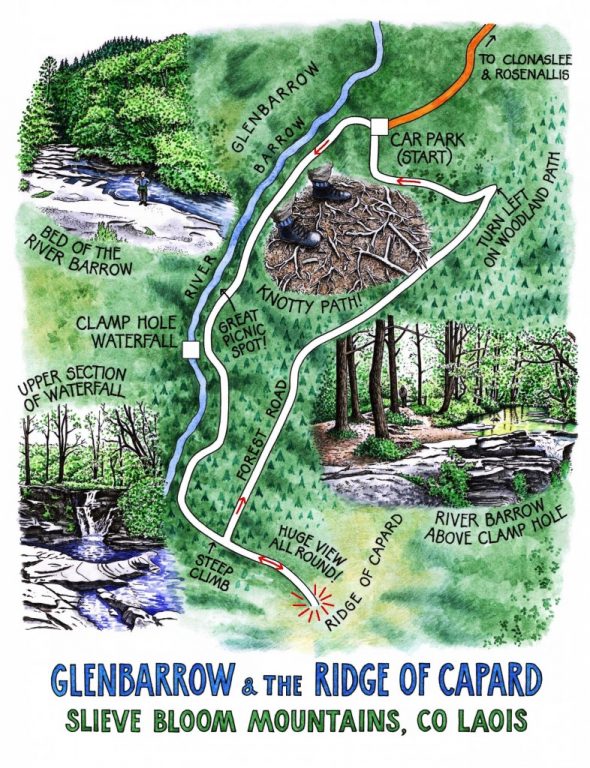Irish Independent – WALK OF THE WEEK – Christopher Somerville
14 August 2010
70. Glenbarrow and the Ridge of Capard, Slieve Bloom Mountains, Co. Laois

There’s something mysterious, half-invisible even, about the Slieve Blooms. These low-rolling hills, rising at the meeting point of Laois and Offaly, are only an hour from Dublin on a good traffic day. But mention them to most people, and you’ll get a puzzled shrug. Partly the modesty of the Slieve Blooms’ public image is down to the fact that they rise from the huge empty expanse of the flat Midlands plain, not a location that most folk would think of as walking country; partly it’s that they fall between hills and mountains in their height and scope. Yet local walkers are fanatical in their devotion; the Slieve Blooms have one of the best walking festivals in Ireland, and one of the keenest and friendliest walking clubs.
It’s hard to believe that such a compact range could hold so many secret valleys and hidden rivers. Glenbarrow is a great example. According to Slieve Bloom myths the Barrow is a river with a furious spirit, capable of apocalyptic floods if its wellhead is interfered with – or even glanced upon. Once roused, the angry waters could only be appeased by being sprinkled with milk from the hand of a virgin priest (they weren’t all, you know).
There was no such rage in the river today. In the narrow cleft of Glenbarrow it rushed shallow and peat-brown through the forest. We walked a pine needle carpet through cathedral-like conifers where long-tailed tits gave out their thin little call, zee-zee-zee, and tiny goldcrests skimmed on white-barred wings from one perch to the next.
Down by the river we ventured out on the jumbled grey boulders and shallow red rock plates of the riverbed. Here the River Barrow pours through the cracks and joints in the soft sandstone, cutting itself miniature waterfalls and foot-high cascades. The sandstone slabs reflect the movement of the river in their many-leaved, blade-thin strata, rippling back from the leading edges like fossilised wavelets. A perfect picnic spot for children to splash and explore, though slippery enough for a bit of care.
A little further along the path we came to a viewpoint where Clamphole Falls came jumping down a series of rock steps in fans of hissing water. A dipper flew up and perched on the rim of the waterfall, its white breast shining like a torch as it bobbed up and down. A flutter of wings and it had dived into the upper pool, to walk upstream underwater in search of caddis-flies and tiny freshwater snails among the stones.
From the falls we followed the trail as it rose out of the trees among wild strawberry (plump, sweet and ripe for picking) and bilberry (on the way there, but still a bit green). Speckled wood butterflies spread themselves among the grasses, opening their beautiful wings of velvet brown with sherbet-yellow spots to catch the sun. The beaked pink flowers of lousewort and the royal blue petals of milkwort studded the open heather, and the gorse in full bloom blazed as brilliant gold as any burning bush.
The view from the crest of the Ridge of Capard was absolutely sensational. Standing in a sea of wind-rippled bog cotton we stared round a complete circle – east as far as the Wicklow Mountains, south to what looked like a squeak of the Comeraghs, Knockmealdowns and Galtees, and north across the brown and green patchwork of the great Midlands plain. In past accounts of walks I have been taken to task by readers for over-estimation after describing ‘hundred-mile-views’ which probably aren’t quite that. So all I’ll say of the Ridge of Capard is that it gives a prospect fit to make you sing. And we did – ‘I Can See For Miles’, at the top of our voices.
A crunchy forest road and a stumbly path over knotty tree roots returned us to the car, our heads full of views, our fingers sticky with lemon-scented pine resin.
WAY TO GO
MAP: OS of Ireland 1:50,000 Discovery 54; downloadable map/instructions (highly recommended) at www.discoverireland.ie/walking.
TRAVEL:
Rail (www.irishrail.ie): Portlaoise (11 miles)
Bus (www.buseireann.ie): Clonaslee-Rosenallis-Mountmellick-Dublin service under consideration (info: 057-8692168)
Road: Side road to Glenbarrow signposted off R422 (Clonaslee-Mountmellick), on bend in Rosenallis. First right, then first left to Glenbarrow car park.
WALK DIRECTIONS: Follow Blue Route (‘Waterfall’; blue arrows/BA). 500 m beyond Clamp Hole waterfall, Blue Route climbs to meet forest road. Cross and climb path (yellow arrows) to Ridge of Capard (superb views). Return to forest road; turn right (BAs). In 1 mile, another forest road rises to right; turn left here (BAs) down forest path, back to car park.
LENGTH: 4 miles: allow 2 hours
GRADE: Moderate
CONDITIONS: Rocks, tree roots underfoot; short sections boggy and steep. Slippery rocks along river. Buggy-friendly along forest roads.
DON’T MISS … !
• Clamphole Falls
• wild strawberries and bilberries on way up to Ridge of Capard
• view from the ridge
REFRESHMENTS: Picnic
ACCOMMODATION: Ardmore House (tel 057-913-7009; www.kinnitty.com) or Aaron House (086-199-5555; www.aaronhouse.ie), Kinnitty, Co. Offaly
GUIDE BOOKS/LEAFLETS: Bladhma by Tom Joyce (Acorn Press)
WALKING in IRELAND: Walking tour operators, local walks including Discover Ireland’s National Loop Walks, walking festivals throughout Ireland: www.discoverireland.ie/walking.
WALKING IN SLIEVE BLOOMS:
Slieve Bloom Guided Walks: Every Sunday until mid-November 2010 – visit
http://www.slievebloom.ie/walking_programme.html; tel 086-278-9147; info@slievebloom.ie
Slieve Bloom Eco Walks Festival: 18/19thSeptember 2010
All walking info: www.slievebloom.ie
INFORMATION:
Portlaoise Tourist Information Office: James Fintan Lawlor Avenue (057-862-1178); www.midirelandtourism.ie
csomerville@independent.ie